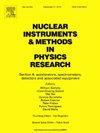A simple combined-objective optimization method for coil configuration of air-core multi-coil magnet systems
IF 1.5
3区 物理与天体物理
Q3 INSTRUMENTS & INSTRUMENTATION
Nuclear Instruments & Methods in Physics Research Section A-accelerators Spectrometers Detectors and Associated Equipment
Pub Date : 2025-07-17
DOI:10.1016/j.nima.2025.170826
引用次数: 0
Abstract
Due to the high current density of high temperature superconducting magnet, it is possible for accelerator magnets to generate sufficiently strong magnetic field without using any iron core. A new optimization method is proposed for this kind of air-core system. This method combine Biot–Savart law and gradient descent method to determine the coil position, geometry and applied current at once, to obtain high accuracy magnetic field and small superconductor usage in the same time. The balance between high field accuracy and low superconductor usage can be adjusted by optimizing the weighting parameter properly. An example of using this method on a cyclotron is given, to show that the optimization can be performed under complicated spatial and current limitation. This optimization method is fast, and can be performed easily using python package without using any high level optimization or calculation technique. With its simplicity and speed, this optimization can be used for various air-core magnet design in the future.
空芯多线圈磁体系统线圈结构的简单组合目标优化方法
由于高温超导磁体的高电流密度,加速器磁体不使用铁芯就可以产生足够强的磁场。针对这类空芯系统提出了一种新的优化方法。该方法结合比奥-萨瓦定律和梯度下降法,一次确定线圈位置、几何形状和施加电流,同时获得高精度磁场和小超导体使用量。通过适当优化加权参数,可以实现高场强精度和低超导体利用率之间的平衡。最后给出了该方法在回旋加速器上的应用实例,表明该方法可以在复杂的空间和电流限制条件下进行优化。该优化方法速度快,无需使用任何高级优化或计算技术即可使用python包轻松执行。该优化方法简单、快速,可用于未来各种空芯磁体的设计。
本文章由计算机程序翻译,如有差异,请以英文原文为准。
求助全文
约1分钟内获得全文
求助全文
来源期刊
CiteScore
3.20
自引率
21.40%
发文量
787
审稿时长
1 months
期刊介绍:
Section A of Nuclear Instruments and Methods in Physics Research publishes papers on design, manufacturing and performance of scientific instruments with an emphasis on large scale facilities. This includes the development of particle accelerators, ion sources, beam transport systems and target arrangements as well as the use of secondary phenomena such as synchrotron radiation and free electron lasers. It also includes all types of instrumentation for the detection and spectrometry of radiations from high energy processes and nuclear decays, as well as instrumentation for experiments at nuclear reactors. Specialized electronics for nuclear and other types of spectrometry as well as computerization of measurements and control systems in this area also find their place in the A section.
Theoretical as well as experimental papers are accepted.

 求助内容:
求助内容: 应助结果提醒方式:
应助结果提醒方式:


